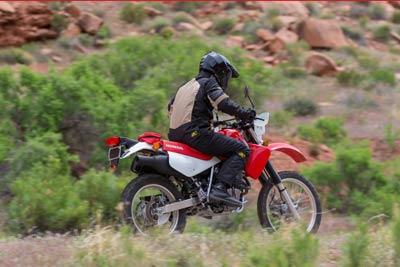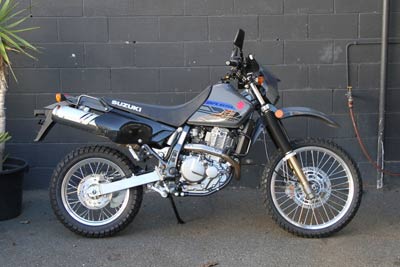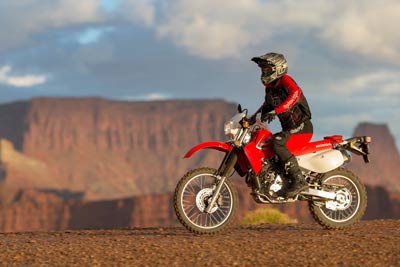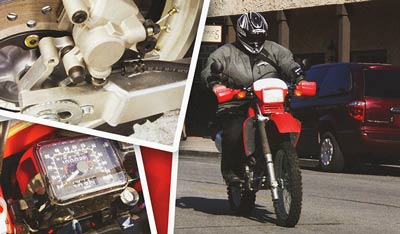The best dual-sport motorcycles come with large front wheels, a torque-rich engine, and long travel suspension. As such, they can easily handle on and off-road conditions, making them popular among beginner and pro riders.
So, how do you define Honda XR650I vs Suzuki DR650? The XR650l is known for its air-cooled engine, high seat height, long travel suspension, larger tire size, and shorter wheelbase size. Meanwhile, the DR650 stands out for its air and oil-cooled engine, high fuel tank capacity, and better braking system.
But how do these two dirt bikes compare in engine type, suspension, tires, wheelbase size, fuel capacity, horsepower, and torque? Read on to find out their similar everyday issues and which is a better choice for your needs.
How Does The XR50l Differ From DR650? – Comparison Table
Below, we will compare the key features of the Honda and Suzuki bikes to help you make a good buying decision
| Features | Honda XR650l | Suzuki DR650 |
| Engine Cooling Mechanism | Air-cooled | Air and oil-cooled |
| Engine Compression Ratio | 8:3 | 9:5 |
| Horsepower and Torque | 40 HP and 47.2 lb.-ft | 43 HP and 47 lb.-ft |
| Fuel and Oil Capacity | 2.8 gallons/ 0.6 gallons reserve, and 2 quarts | 3.4 gallons and 3 quarts |
| Seat Height | 37 inches | 34.8 inches |
| Suspension System Travel Size | 11.6 inches front and 11 inches rear | 10.2 inches front and rear |
| Wheelbase Size and Ground Clearance | 57.3 inches and 13 inches | 58.7 inches and 10.4 inches |
| Braking System | Single front and rear disc each measuring 240 mm | Front disc measures 290 mm and rear disc 240 mm |
| Tire Size | Front is 80/100-21 and rear 110/100-18 | Front is 90/90-21 and rear 120/90-17 |
| Exhaust System | Made of aluminum and stainless steel materials | Made of stainless steel only |
| Wet and Dry Weight | 347 lbs and 324 lbs | 366 lbs and 324 lbs |
XR650l vs DR650 Differences
Having a hard time choosing between XR650l vs DR650 dual sport motorcycle? Check out their many differences before making your purchase.
Engine
The XR650l engine is only air-cooled, while the DR650 is air and oil-cooled. So, the DR650 engine boasts an additional cooling mechanism, making it much more efficient than the XR650l when riding for extended periods.

In addition, the engines also differ in compression ratio. The Honda model has a compression ratio of 8:3, while the Suzuki has a 9:5. Generally, the higher the ratio, the greater the engine’s power output. So, the Suzuki engine gives out more horsepower than the Honda.
Power and Torque
Honda XR650’s four-stroke engine produces about 40 horsepower and 47.2 lb.-ft of torque. On the other hand, the DR650 delivers around 43 hp of power and 47 lb.-ft of torque. So, the Suzuki dirt bike is slightly more powerful than its Honda counterpart.
Fuel and Oil Capacity
The fuel tank capacity of the XR650l is only 2.8 gallons with 0.6 gallons reserve. Its oil capacity is 1.9 L or 2 quarts. Meanwhile, the Suzuki model fuel tank boasts 3.4 gallons and its oil capacity is 3 quarts or 2.8 L.
Therefore, you can get more miles out of the Suzuki than the Honda on a full tank, ensuring minimal stops. On the flip side, the Suzuki uses more engine oil than the Honda.
Seat Height

Honda’s XR650l seat height is 37 inches, while that of the Suzuki is 34.8 inches. The high height of the Honda allows people of different lengths to ride the bike. However, if you’ve got short legs, you will find the Suzuki more comfortable to ride than its Honda counterpart.
Suspension System
With the XR650l, you get an air-adjustable front suspension featuring a Showa cartridge fork and compression-damping adjustability. The suspension also boasts 11.6 inches of travel.
Its rear suspension features single shock with rebound-damping adjustability and spring preload, along with 11 inches of travel. The Suzuki’s front suspension is coil spring and boasts a telescopic fork.
Meanwhile, the rear suspension is a link-type with an adjustable spring preload. Both suspensions are oil damped and offer 10.2 inches of travel.
Overall, the suspension system of the Honda XR650l absorbs all unpleasantries better than the Suzuki, giving you a smoother ride. Further, its long travel makes it even better for high lifts and cruising on rough trails.
Wheelbase Size and Ground Clearance
The XR650l boasts a 57.3 inches wheelbase size and 13 inches of ground clearance. On the other hand, Suzuki has a wheelbase size of 58.7 inches and 10.4 inches of ground clearance.
Therefore, thanks to Suzuki DR650’s relatively long wheelbase and shorter ground clearance, it gives you better handling and stability than the Honda. However, the Honda makes cornering and cruising over obstacles more effortless due to its shorter wheelbase and better ground clearance.
Vibration Issues
With the Honda XR650l, you may experience engine vibration issues in third gear or at high RPMs. Handlebar vibrations are also typical. But with the DR650, you may encounter vibrations in the fourth and fifth gears. The good news? These vibration issues can be alleviated.
Braking System

With the Honda, you get a single disc front and rear braking system, each measuring 240 mm. However, the front brake is outfitted with a twin-piston caliper that utilizes two brake pads. This provides you with a better brake feel and initial bite.
Conversely, the Suzuki DR650 features a front floating disc brake at 290 mm in size with two-piston calipers. Its rear brake also boasts a two-piston caliper and is 240 mm in size. Therefore, the Suzuki can provide more stopping power than the Honda, thanks to its front brake’s larger diameter.
Tire Size
The XR650l has relatively larger tires than the DR650. This gives the bike better handling and stability on rough terrains. Its front tire measures 80/100-21, and the rear tire 110/100-18.
With the DR650, its front tire measures 90/90-21 while the rear tire is 120/90-17. The first number represents the tire’s width, and the second is the tire’s wall height. Meanwhile, the third number is the rim size.
Type of Exhaust and Muffler
The Honda features FMF Powercore 4 slip-on exhaust and muffler built to deliver improved power and torque. This exhaust system is made of stainless steel and aluminum materials for durability. However, this exhaust system is prone to leaking and breaking at the mid-pipe.
As for the exhaust system of the Suzuki DR650, it comprises two parts, including the head pipe and muffler. The muffler is a slip-on type and made of stainless steel materials only. Overall, the Suzuki exhaust muffler is more durable than its Honda counterpart but relatively heavy.
Weight and Handling
A Honda XR650 has a whooping wet weight of 346 pounds, and its dry weight is 324 pounds. The wet weight includes the bike’s standard equipment, full fuel tank, and the necessary fluids.
On the other hand, the Suzuki boasts a wet weight of 366 pounds while its dry weight is 324 pounds. You will find the Suzuki hard to ride at slow speeds and in tight corners, especially on-road because of its heavy wet weight.
Meanwhile, the Honda is more efficient in handling, power output, and fuel efficiency both on and off-road as it is lighter.
Any Common Issues Between Honda XR650L VS Suzuki DR650?

Despite the many XR650l vs DR650 differences, these two dual-sport motorcycles have some common issues, including:
Excessive Vibration
This issue is typical on the handlebars of both dirt bikes, especially when cruising at high speeds. The good news is the vibrations can be mitigated by adding handlebar weights, heavier engine flywheels, or a rubber snake.
The flywheels reduce vibrations by leveling out the power stroke, while the bar weights lower the vibration frequency. You could also replace the steel bars with aluminum ones.
Rear Brake Issues
The rear brakes of both the XR650l and Suzuki DR650 are prone to failure over time. They may slow the bike but not stop it or may quit operating out of the blue. In this case, the best way to mitigate the issue is to bleed the brake and replace the brake pads when worn out.
Electrical Problems
With both bikes, you may experience intermittent electrical issues. These issues are usually due to a blown fuse, bad battery, or loose wiring connection, especially from the ignition switch.
Cold Hard Starting
Another common issue with these two bikes is they are difficult to start when the engine is cold. Both bikes take a long time to fire up unless you crank the motor with the choke off. This problem occurs when you do some mods on the motorcycle.

FAQs Suzuki DR650 vs Honda XR650l
Now let’s check out some frequently asked questions regarding the DR650 vs XR650l dual-sport bikes.
Q: Do the XR650l and DR650 have any Similar Features?
Yes, they have similar features. Both bikes are powered by a 644 cc 4-stroke single-cylinder engine, backed by a one-year warranty, and cost about the same. Also, they feature a 5-speed transmission and the same bore and stroke size.
Q: What Is The Gas Mileage Of The XR650l And DR650?
The average gas mileage for the Honda XR650l is 52 miles per gallon, and 45-57 mpg for the DR650. However, this may vary depending on the road conditions, riding speeds, and cargo weight.
Q: What is the XR650l and DR650’s Top Speed?
Because of the Honda XR650l’s reduced weight, it can reach close to 105 mph of maximum speeds. Meanwhile, you can hit up to 100 mph speeds with the DR650.
Conclusion
Although there are several DR650 vs XR650l common issues, what stands out are their differences. These include their cooling mechanism for the engine, wheelbase size, seat height, tire size, and suspension system. So, keeping their differences in mind, the Honda XR50l is a better choice in so many ways.
First, it has relatively bigger tires ensuring better traction and stability when riding at high speeds. Secondly, the bike has a shorter wheelbase, making cornering easier. Also, it is slightly lighter than the D650, ensuring better power output and handling even at top speeds.
.